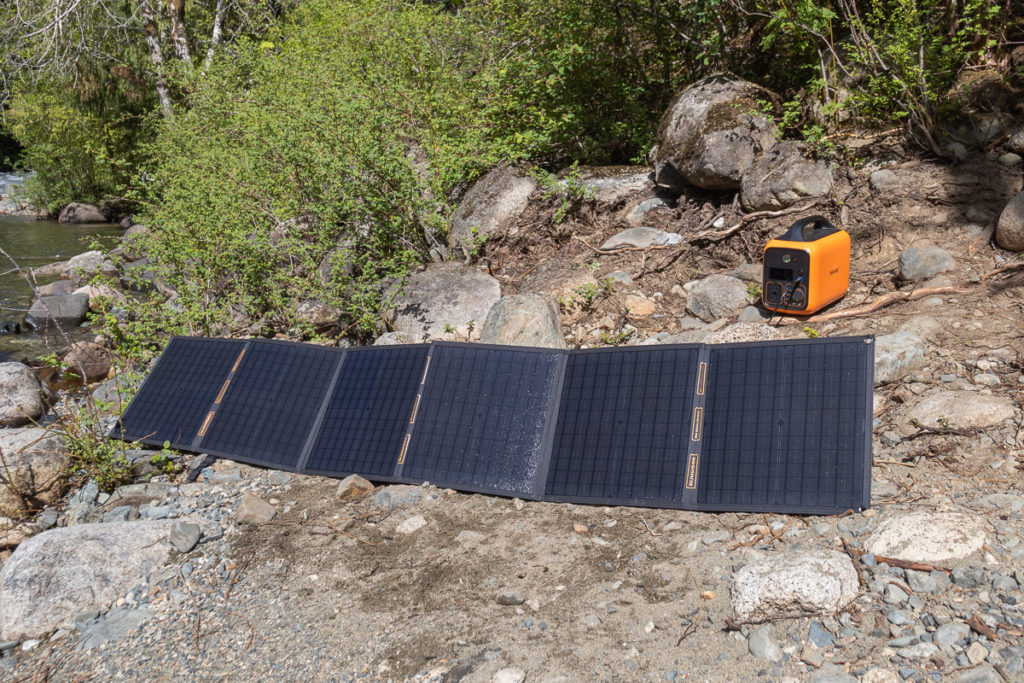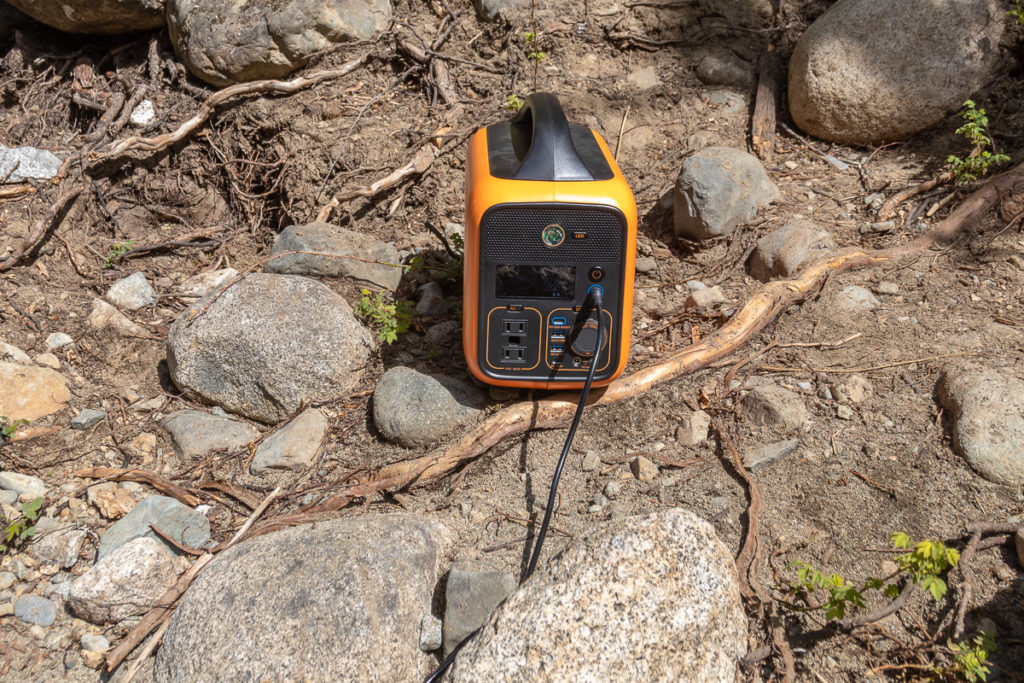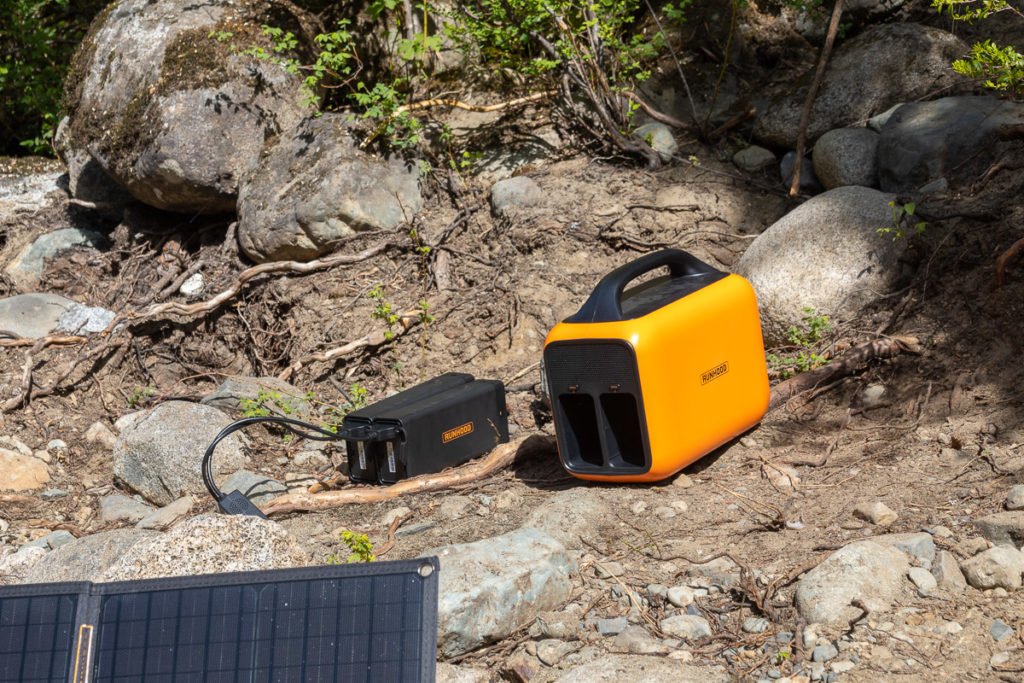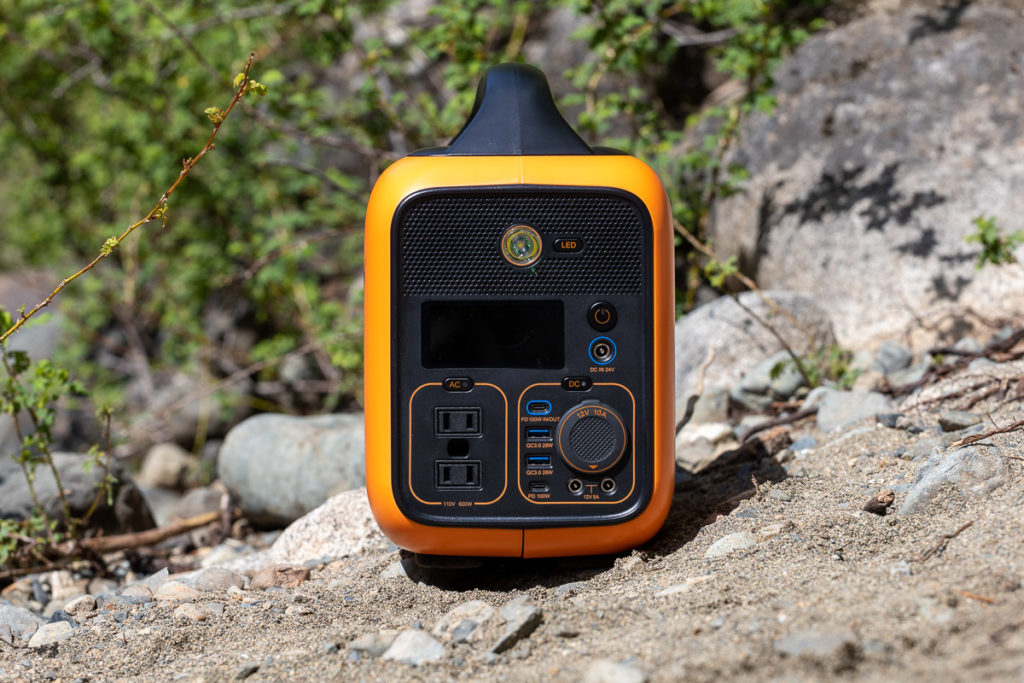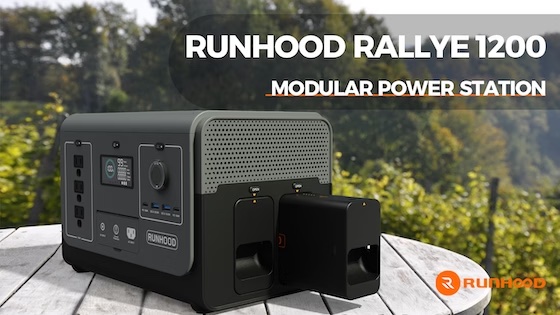Power stations are normally just big batteries. The ports charge your devices and recharge the battery.
They’ve gotten better over recent years but they’ve mostly remained a big battery with USB and AC outlets.
You’ve probably never heard of Runhood Power before but in 2021 they debuted their first product: the RALLYE 600, a power station with a twist.
The 600 has removeable battery packs called ‘energy bars’ that can be added or removed whenever you need to charge. The main ‘host engine’ can hold 2 energy bars, each with 324 watt-hours (Wh) of energy. It can power any number of devices up to 600 watts. When one energy bar is drained you can slide another in. Rad.
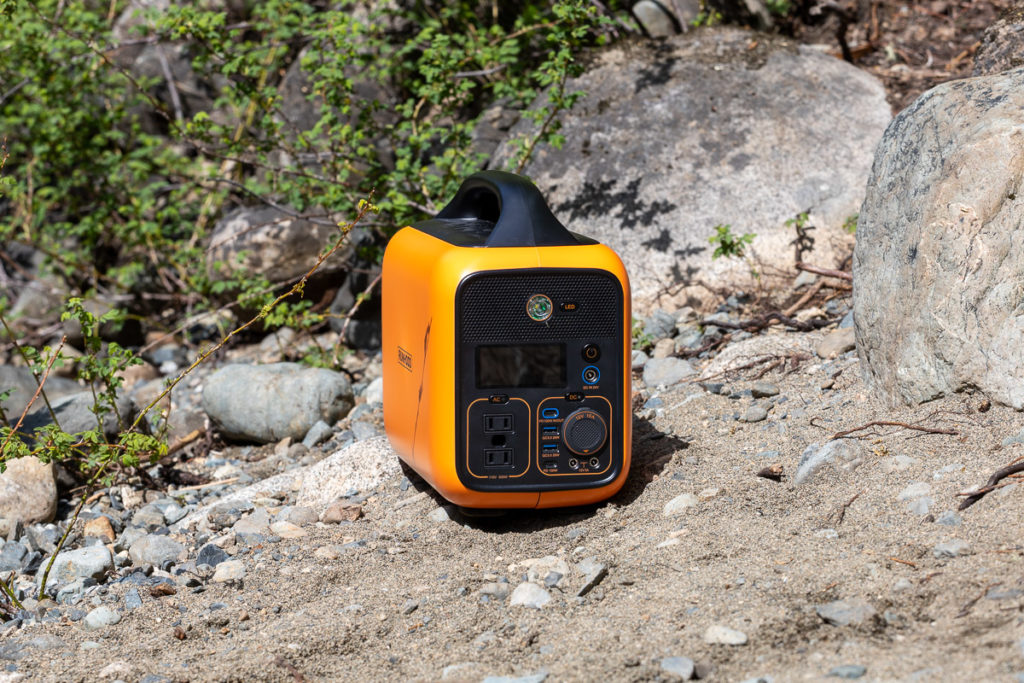
I tested the RALLYE 600 Pro package with the host engine, 4 energy bars, AC engine, USB engine and SERI 100 solar panel.
Here’s the quick Pros and Cons if you are short on time.
Pros
- Multiple hot-swappable batteries
- Numerous ways to charge
- Charge from the host engine or energy bar
- Charge an energy bar while using the host engine
- 4 USB-C PD 100W ports (with USB engine)
Cons
- No USB-C cords included
- Only 600 watts (1200 watt version coming soon)
How does the RALLYE 600 work?
The RALLYE 600 isn’t your typical battery.
The host engine is the main case, what would normally be the whole battery. It holds two 324 watt-hour energy bars for a total of 648 watt-hours. It can charge as many devices as you want up to 600 watts continuous but 1200 watts surge.
There are 4 different packages that come with different combination of parts.
- Pro
- Host engine
- 4 Energy Bars
- AC Engine
- USB Engine
- Seri 100 Solar Panel
- Plus
- Host engine
- 4 Energy Bars
- Seri 100 Solar Panel
- Max
- Host engine
- 4 Energy Bars
- AC Engine
- USB Engine
- Standard
- Host engine
- 2 Energy Bars
- Juice Pack ($399 USD)
- 2 Energy Bars
- Energy Bar and Small Engines ($288 USD)
- 1 Energy Bar
- AC Engine
- USB Engine
- Energy Bar ($219 USD)
- 1 Energy Bar
The packages with the host engine comes with a nice accessory case for all the cords.
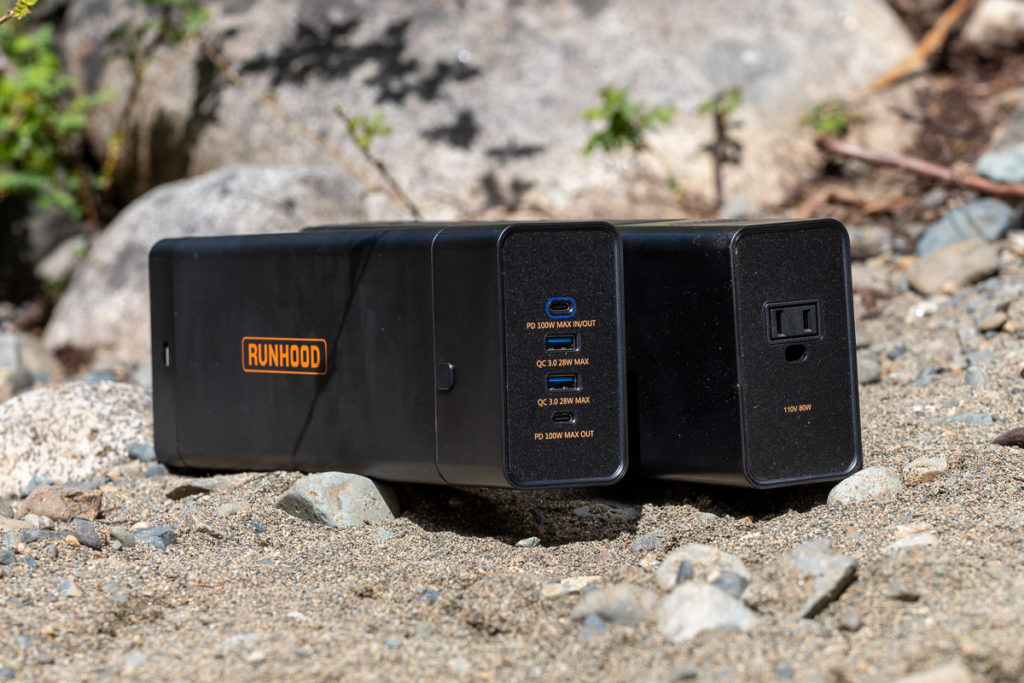
Host Engine
The Host Engine is basically a box with a handle. Two energy bars slide in one side. The other end has all the ports.
Output ports for charging your devices:
- 2 AC output (pure sine wave 110V 60Hz), total 600W (peak 1200W)
- 2 USB-C PD 100W (total 200W)
- 2 USB-A QC 3.0 28W (total 56W)
- 2 DC 12V 5A 60W (total 120W)
- 1 Car port (12V 10A 120W max)
Both USB-C ports will output 100 watts at the same time so that’s helpful for bigger USB devices like laptops.
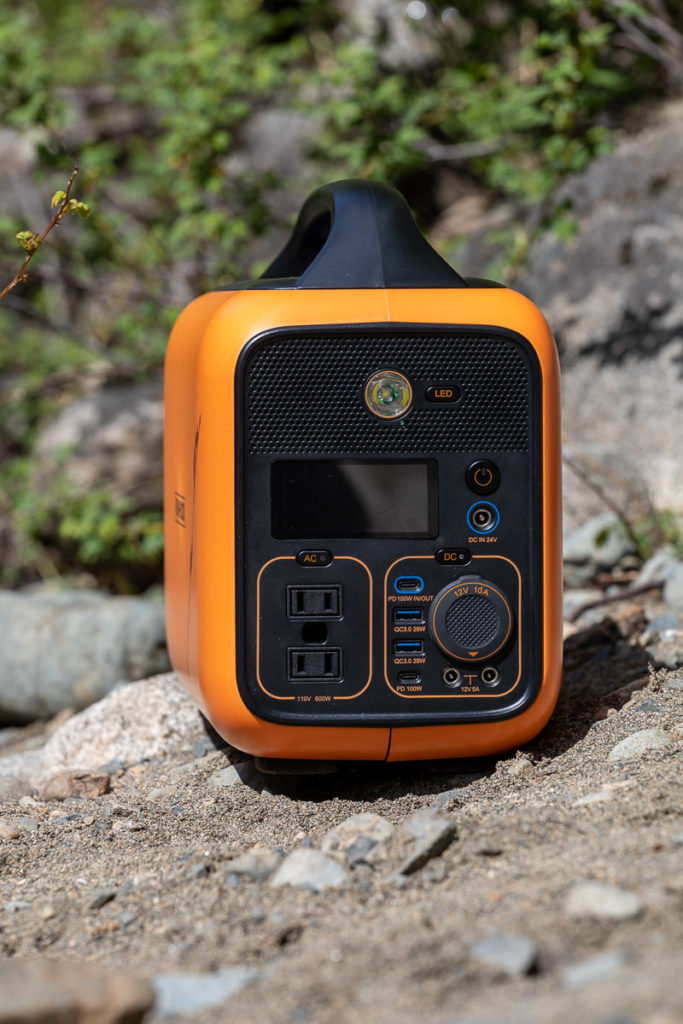
Input ports:
- USB-C PW 100W (one of the output ports)
- 24V DC port (3 ways to charge)
- 1*Solar panel 15V-23V 10A max, MPPT supported
- 1*Adapter 180W
- 1*Car charger 12V 10A 120W
You can charge the host engine through the USB-C and DC ports at the same time up to 250 watts max for a faster charge. It takes about 4 hours to charge 2 energy bars on AC, 6 hours on a car charger. All the ports can charge other devices while charging the host engine.
Right above all the ports is a small light. One click turns it on low, a second click goes to a high brightness. Third is an SOS light pattern.
A small screen above all the ports shows the current charge and watts in and out. You can increase or decrease the brightness on the screen if you want.
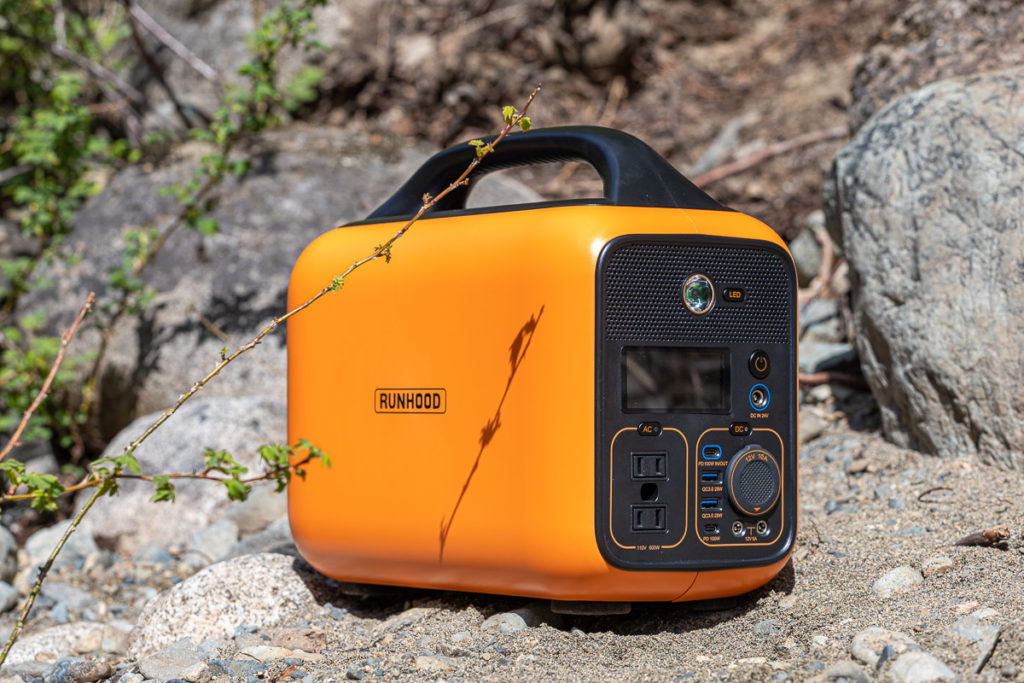
Energy Bars
The key to this whole power system is the Energy Bars. They are 324 watt-hour battery packs that slide in and out of the host engine. They have a small connection on the end that plugs into each engine and transfers power.
To compare these massive batteries to smaller pocket-sized batteries, the 324 watt-hours convert to about 90,000 mAh. An iPhone 14 battery is 3279 mAh so these Energy Bars can charge over 27 times from completely dead (If it stays off. They consume more power when they’re turned on an charging).
Rather than having to charge the whole host engine, youc an just charge each energy bar. There’s a solar adapter to plug straight into 2 energy bars and charge them. Or you can charge an energy bar with the USB engine on it. They are smaller to store or hide from the side if it’s just 1 or 2 energy bars too.
Of course, you can still charge 2 energy bars inside the whole host engine as well.
USB and AC Engines
The host engine has the most ports and highest power rating from all the engine but it’s also much larger than just an energy bar. If you want to just charge something smaller, one energy bar can do it with the help of the AC or USB engines.
They are just a black cap that fits onto the end of the energy bars and provides either 1 AC port in the case of the AC engine or 2 USB-C and 2 USB-A ports with the USB engine.
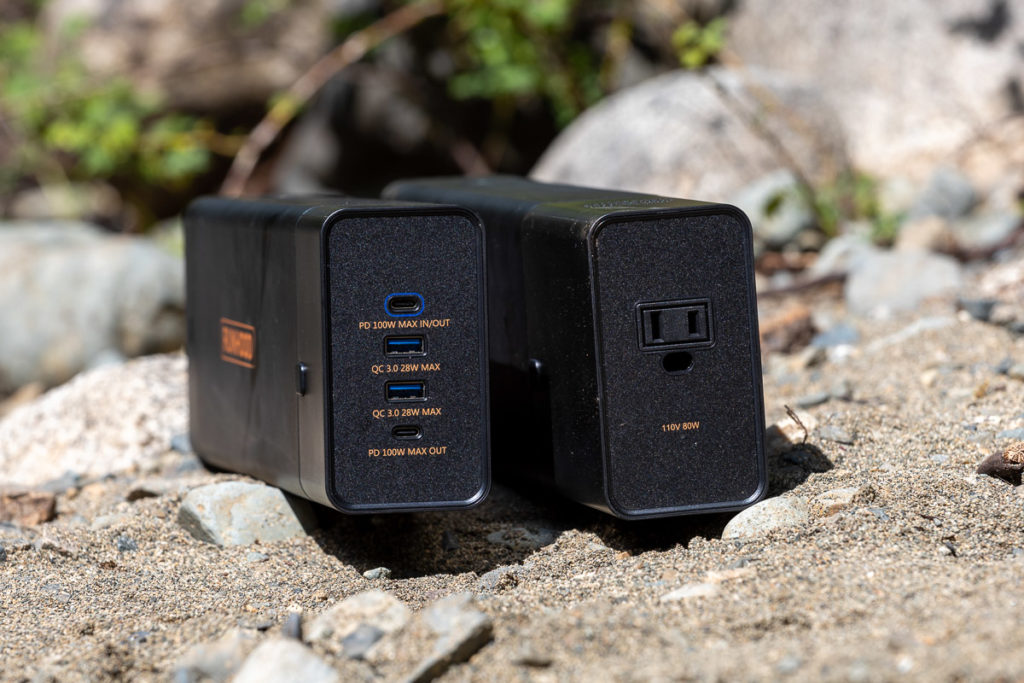
There are 4 ports on the USB engine: 2 USB-C 100W ports, and 2 USB-A QC 3.0 28 watt USB-A ports. One of the USB-C ports is bi-directional so it can charge the energy bar or charge your devices. Using all 4 ports there’s a limit of 256 watts.
The AC engine is one AC plug. It has a limit of 80 watts which is low for an AC outlet but it’s nice for charging small devices.
Charging Energy Bars
To charge up the whole system, there are a couple different ways to do it.
The easiest way is to put two energy bars into the host engine and plug it in. It will charge up the energy bars inside.
The other way is to charge the energy bars directly from USB-C with the USB engine or plug the solar adapter directly into the energy bars.
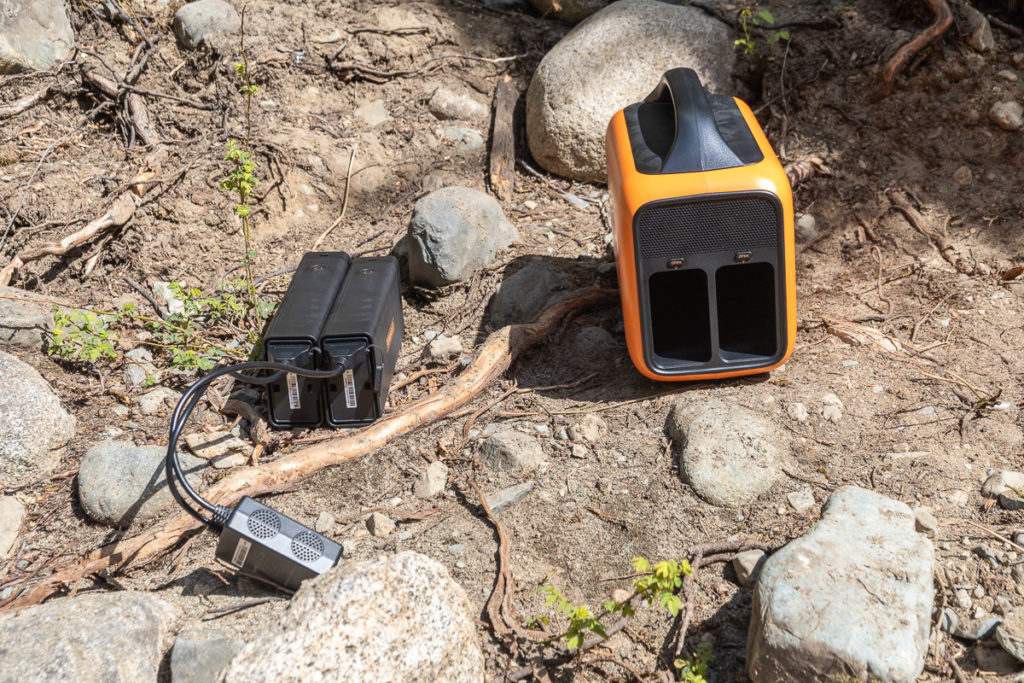
When the batteries are low in the host engine, there’s a quiet beep.
The host engine works with only one energy bar so you can be charging one or 2 energy bars outside with solar and using the host engine inside.
Many batteries in one
The main draw of the RALLYE 600 is the modular system.
You can swap out batteries that are dead and plug them into a solar panel outside while the host engine is still running.
The USB and AC engine give you other options to charge or use the energy bars than just the main host engine.
If any of the batteries wear out you can buy a new energy bar without having to buy a whole new unit.
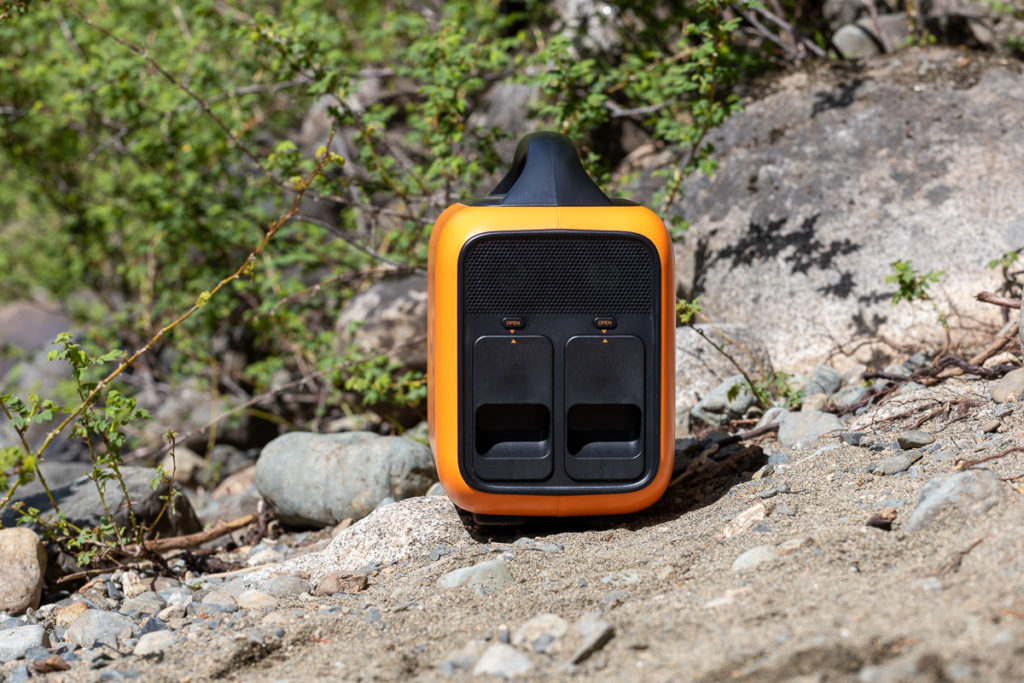
Seri 100 solar Panel
The 18V, 5.5A Seri100 solar panel comes in the RALLY Pro and Plus packages but you can buy it separately for $393 CAD ($289 USD). It’s got an IPX6 waterproofing rating so a bit of rain won’t hurt it.
Most 100 watt solar panels are 2 panels that fold out but the Seri100 is actually 6 smaller panels. It packs down into a small package 36 x 36 x 6 cm (14.2 x 14.2 x 2.3 in). Unfolded it’s quite long at 230 x 36 x .5 cm (90 x 14.2 x .2 in). Each panel has a little kickstand on the back to tilt it toward the side. Grommets run down both sides so it’s easy to hang horizontally or vertically.
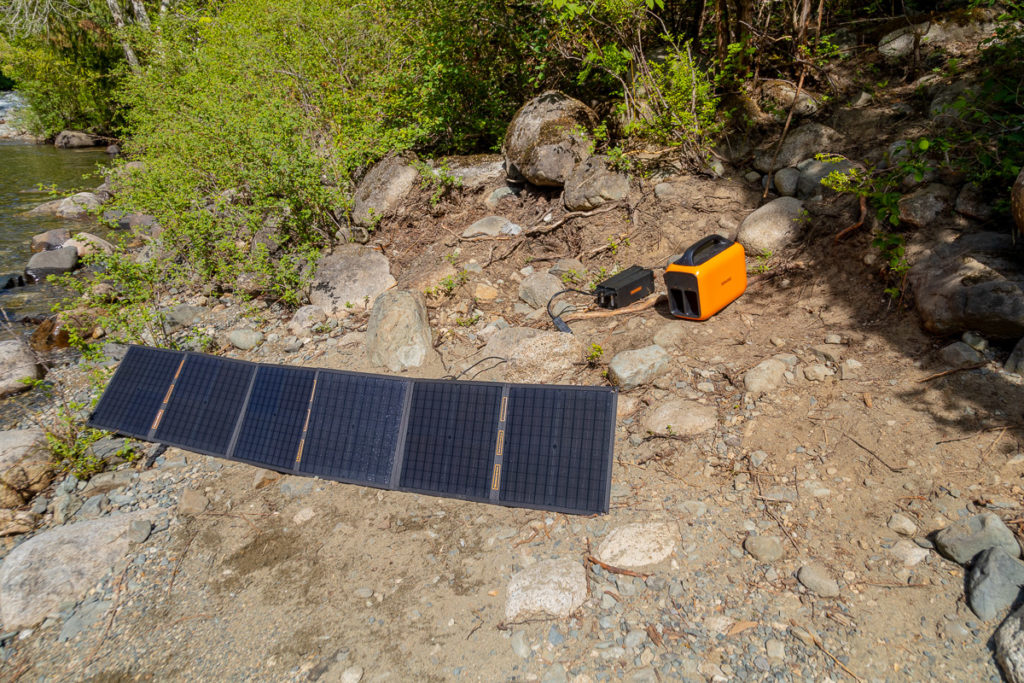
The panel comes with an MC4 connector. The RALLYE host engine comes with an MC4 to DC connection. 2 panels can be chained for 200 watt charging.
In my testing, I was getting 70 to 80 watts from spring sun in the Pacific Northwest. Pretty standard for around here.
There is also an adapter (Solar Charger SC200) to go from DC directly to the energy bars. Charging the smaller energy bars lets you use the host engine somewhere else and it’s easier to keep the smaller bars out of the sun.
Full Specs
- Lithium-ion (NMC) energy bars
- 648 watt-hours max in host engine
- 600 watts (1200 watts max)
- 1000 charges to 80%
- Rubber battery covers cover battery ports
- Weight
- Power station without batteries – 9 pounds, 8.2 pounds?
- Power station with 2 batteries – 16.8 pounds? 15.8 pounds?
- One energy bar – 1.7 kg (3.8 pounds)
- USB engine
- AC engine
- Charge Times
- AC 3.5 hours
- Solar 8 hours
- Car outlet 5.5 hours
- USB-C 3.5 hours
- AC + USB-C 2.5 hours
- 33 x 17.3 x 22.4 cm (13 x 6.8 x 8.8 in)
- $1642 CAD ($1199 USD) for PRO package (Host engine, 4 energy bars, USB engine, AC Engine, Sere100 solar panel) – on sale right now
Comparison
In the table below, I compare the RALLYE600 host engine and 2 energy bars to a bunch of other popular power stations around 600 watt-hours.
The Runhood has the largest capacity of the bunch and is the only one with removable batteries so is slightly heavier and more expensive.
| Runhood RALLYE 600 | BioLite BaseCharge 600 | EcoFlow RIVER Max | Bluetti EB55 | AllPowers S700 | Energizer PPS700 | |
| Weight | 7.2 kg 16 pounds | 6.5 kg 14 pounds | 7.7 kg 17 pounds | 7.5 kg 16.5 pounds | 5.3 kg 11.68 pounds | 6.87 kg 15.15 pounds |
| Size | 33 x 17.3 x 22.4 cm 13 x 6.8 x 8.8 in | 30.9 x 20 x 20 cm 12.2 x 7.9 x 7.9 in | 28.9 x 18.4 x 23.5 cm 11.4 x 7.3 x 9.3 in | 27.8 x 20 x 19.8 cm 10.94 x 7.87 x 7.79 in | 26.5 x 13.97 x 17.78 cm 10.4 x 5.5 x 7 in | 26 x 17.3 x 20.2 cm 10.24 x 6.81 x 7.95 in |
| Capacity | 648 Wh (with 2 bars) | 622 Wh | 576 Wh | 537 watt-hours | 606 Wh | 626 Wh |
| Power Rating | 600W 1200W surge | 600W 1000W surge | 600W 1200W surge | 700 watt 1400 watt surge | 700W 1400 surge | 600 watt 1200 watt surge |
| Removable batteries | Yes | No | No | No | No | No |
| Input Ports | DC port (Input for AC, solar, car port) 1 USB-C PD 100W | 1 HPP 400W (Input for AC, solar) 100W USB-C PD | DC (Input for AC, car port, solar) | DC MPPT (Solar 200W) DC Barrel (AC 200W, 12/24V car port) * 400W with solar and AC | DC (AC input) DC MPPT (Solar input) USB-C 60W | DC (Input for AC 100W, Solar 12-30V 100W) USB-C 60W |
| Output Ports | 2 AC 110V (600W) 2 USB-C PW 100W 2 USB-A QC3.0 28W 2 DC 12V 5A 60W 1 Car port 12V 10A 120W * Another 2 USB-C and 2 USB-A on the USB engine. Another 80W AC on the AC engine. | 2 AC 1 USB-C PD 100W 1 USB-C 5V/3A 1 USB-A 5V/3A 1 DC 120W car charger 2 5.5mm DC barrel 120W 10W Wireless Charging mat | 3 AC 120V (600 watt) 1 USB-C PD 100W 1 USB-A 18W 2 USB-A 12W Car port 136W 2 DC5521 13.6V DC | 4 120V AC (700 watt total) 1 USB-C PD 100W 4 USB-A 5V/3A 1 12V car outlet 2 DC5521 (1) 15 watt charging pad | 2 110V AC 1 USB-C PD 100W 3 USB-A 5V/3A 2 DC 12V/5A 1 Car port | 1 AC 110V 1 USB-C PD 60W 1 USB-A QC 3.0 18W 3 USB-A 15W 2 x DC5521 (12-16.8V) 1 car port |
| Charge Time | AC 3.5 hours Solar 8 hours USB-C 3.5 hours AC + USB-C 2.5 hours Car port 5.5 hours * charging 2 batteries in the host engine | AC 7 hours AC+USB-C 3.5 hours 100 W solar panel 6 hours | AC 1.6 hours 12V car port 6.5 hours 220W solar 3-6 hours | AC 3 hours Solar 200W 3 hours 200W car port 3.4 hours AC+Solar 2 hours Dual AC 400W 2 hours. | AC 6 hours USB-C 10 hours Solar 6 hours Car port 12 hours | AC 3-4 hours USB-C PD 60W 13 hours Solar 7-8 hours 12V car port 3-4 hours |
| Cost per watt | $1.07 USD/watt-hour $1.48 CAD/watt-hour * Host engine and 2 batteries | $1.12 USD/watt-hour $1.44 CAD/watt-hour | $.86 USD/watt-hour $1.38 CAD/watt-hour | $.92 USD/watt-hour $1.11 CAD/watt-hour | $.71 USD/watt-hour $.99 CAD/watt-hour | $.63 USD/watt-hour $.86 CAD/watt-hour |
| Price | $699 USD $963 CAD * Host engine and 2 batteries | $699 USD $899 CAD | $499 USD (sale) $799 CAD | $499 USD $599 CAD | $429 USD (sale) $599 CAD | $399.00 USD $544.30 CAD |
| Link | Runhood.com | BioLiteEnergy.com | EcoFlow.com | BluettiPower.com | iAllPowers.com | EnergizerPPS.com |
RALLYE 1200 Power Station
If 600 watts isn’t enough, the RALLYE 1200 coming out soon. It’s currently here on Kickstarter until June 12. If you’ve been following along, you’ll already guess that it’s a 1200 watt version of the RALLYE 600.
The host engine on the 1200 is slightly larger with 3 AC outlets, 2 USB-C and 2 USB-A outlets. It can hold two 324 watt energy bars just like the 600 but the max power output is 1200 watts.
Verdict on the RALLYE 600
Though a little more expensive than regular power stations, the RALLYE 600 gives you far more options.
If you plan to use two energy bars and never remove them to charge, or use with the small engines, then maybe it’s not worth it for the extra weight and cost of a modular system.
But if you do want to use the energy bars as they’re own battery or want to swap out batteries as you use them, then the Runhood is the only option this size on the market right now.
I love the flexibility of it. I can use the whole host engine or just an energy bar when I need to go smaller. It’d be nice if the max output was a little higher at only 600 watts but the 1200 is coming out soon so that’s going to be exactly what people with larger appliances need. For myself, I usually need to charge laptops, drones, phones and tablets. The 600 can do that without blinking. If I’m going lighter, all I need is one of the energy bars with the USB engine.
Runhood RALLYE 600 FAQ
How many watt-hours are the energy bars?
324 Wh
Can you charge the battery itself and devices at the same time?
Yes.
Can you charge the battery with AC and USB-C 100W at the same time?
Yes.
Does it work with only 1 energy bar installed?
Yes.
Can you replace an energy bar while it’s running?
Yes.
Are the AC outlets grounded?
No.
What battery type are the RALLYE energy bars?
NMC batteries, 1000 cycles to 80%
More Photos
